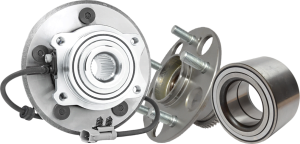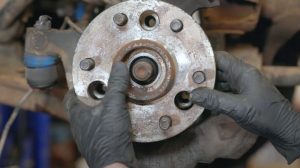A smooth, stable ride depends on more than just your tires and suspension. Your hub and bearing assembly plays a critical, often-overlooked role in maintaining vehicle stability, steering precision, and safety. But like any mechanical part, these components wear down over time. If ignored, worn bearings can lead to uneven tire wear, poor handling, or even wheel separation.
This practical guide is for both drivers and technicians, offering a clear overview of how to identify and diagnose hub and bearing wear before it leads to serious issues — or costly repairs.
What Are Hub and Bearing Assemblies?

A wheel hub assembly includes the hub (which mounts the wheel), the bearing (which allows the wheel to spin with minimal friction), and in modern cars, integrated sensors (like ABS). It’s a sealed unit that supports the wheel’s rotation and keeps it aligned.
Why Do Hubs and Bearings Wear Out?
Hub and bearing wear is often caused by:
-
Heat and friction from constant rotation
-
Water, road salt, or debris penetrating seals
-
Overloading or towing
-
Incorrect installation or lack of torque
-
Driving on rough or uneven roads
Over time, the lubricant inside the bearing breaks down, and the precision-machined surfaces degrade — increasing friction and heat, leading to failure.
Common Symptoms of Worn or Failing Bearings
| Symptom | What It Indicates |
|---|---|
| Grinding or humming noise | Bearing surface degradation |
| Steering looseness or play | Worn hub assembly or inner race looseness |
| ABS warning light | Integrated ABS sensor failure (in modern hubs) |
| Uneven or rapid tire wear | Misalignment caused by a worn hub |
| Vehicle pulling to one side | Uneven resistance due to a failed bearing |
| Wheel wobble or vibration | Excessive play or bearing disintegration |
How to Diagnose Hub and Bearing Wear
For Drivers: Quick At-Home Checks
If you’re a car owner, you can spot early warning signs with the following DIY checks:
1. Listen While Driving
-
Humming or Growling Noise: Gets louder with speed or when turning.
-
Clicking or Popping: Especially during tight turns.
2. Feel for Vibration
-
Steering wheel vibration at low speeds or under braking may suggest a worn bearing.
3. Check Wheel Play (If Safe to Do So)
-
Jack up the car safely.
-
Grab the tire at 12 and 6 o’clock positions and wiggle it.
-
Any noticeable play could indicate bearing or hub wear.
Note: Always use proper safety equipment when lifting your vehicle.
For Technicians: Hands-On Diagnostic Techniques
1. Road Test Evaluation
-
Note when noise starts: under load, acceleration, braking, or turns.
-
Determine which side is louder — noise increases on the opposite side during turns.
2. Lift and Spin Method
-
Spin each wheel while elevated.
-
Listen for roughness or scraping.
-
Rotate by hand to feel resistance.
3. Dial Indicator Test
-
Use a dial indicator to check runout or play in the hub.
-
Excessive movement beyond factory spec confirms wear.
4. ABS Scan Tool
-
For modern vehicles, use a diagnostic scanner.
-
Faulty speed sensors in the hub will trigger ABS codes (e.g., C0035, C0040).
How Long Do Hub and Bearings Last?
| Vehicle Type | Average Lifespan |
|---|---|
| Passenger cars | 120,000 – 160,000 km |
| SUVs & trucks | 100,000 – 140,000 km |
| Performance vehicles | 80,000 – 120,000 km |
Driving habits, load, and road conditions can significantly impact lifespan.
When to Replace vs. Repair

Most modern hub and bearing units are non-serviceable — meaning once they fail, they must be replaced as a sealed unit.
Replace your hub/bearing assembly if:
-
You hear persistent grinding or growling
-
There is visible or measurable play
-
ABS issues trace back to the hub sensor
-
The bearing has already overheated
Pro Tip: Always Replace in Pairs
Even if only one side shows symptoms, the other side likely has similar wear — especially if both were installed together originally. Replacing both ensures balanced performance and safety.
Choosing the Right Hub and Bearing
Look for these key factors when selecting a replacement:
-
OEM quality or better
-
ABS sensor compatibility
-
Proper bolt pattern and spline count
-
Manufacturer warranty
Looking for reliable replacements? Buy Hub & Bearings online for a wide selection of quality-tested parts that meet or exceed OEM standards.
Final Checklist: Diagnosing Hub and Bearing Wear
| Step | Action |
|---|---|
| Listen during driving | Humming, grinding, clicking |
| Check for steering play | Loose or vague steering feel |
| Perform wheel wiggle test | Check for free play at 12/6 and 3/9 positions |
| Use scan tool (if applicable) | Look for ABS sensor faults |
| Check for runout | Use dial indicator if available |
| Inspect tire wear | Uneven wear may suggest alignment issues |
Conclusion
Hub and bearing wear often develops slowly — but ignoring the signs can lead to dangerous failures. With proper diagnosis and timely replacement, you can restore your vehicle’s stability, steering precision, and safety.
Whether you’re a DIY enthusiast or a professional technician, knowing how to spot bearing wear early will save you time, money, and hassle down the road.
Ready to replace? Buy Hub & Bearings online from trusted brands and get the right fit for your vehicle today.